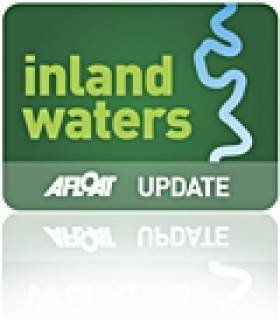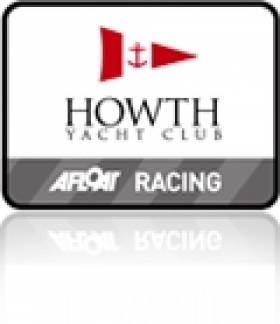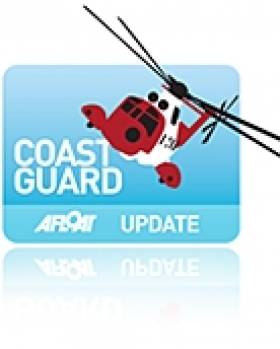Displaying items by tag: RTE
Waterways Returns to the Screen This Sunday
Waterways returns to RTÉ television after 16 years off the air this coming Sunday.
The original award-winning 1990s documentary series saw naturalist and poet Dick Warner undertake an epic journey traversing the canals of Ireland by barge.
This year filmmaker Stephen Rooke accompanied Warner as he returned to our inland waterways, this time to explore the newly restored Royal Canal and celebrate the reopening of the entire route from Dublin to the Shannon.
As previously reported on Afloat.ie, Warner travels on the Rambler, an original canal tug barge, from Dublin to Lough Ree - the first time it had followed the route since 1923.
Along the way, Warner meets both experts and ordinary people who live along the banks, learning from them about its heritage, history and wildlife.
Filming is now complete on the new six-part series, Waterways - A Royal Canal, which begins this Sunday night.
According to Irish Film and Television News, Rooke re-assembled the core team from the original series, many of whom have gone on to work on successful films and TV shows.
The series begins on RTÉ One at 8.30pm on Sunday 2 October.
500 Boats will Kick Start the Dublin Sailing Season this Weekend
There could be anything up to 500-boats afloat for events right across the bay and out in to the Irish Sea.
Joining the 390 boat DBSC fleet for its 128th season is a gathering of over 300 dinghies in Dun Laoghaire for the Mitsubishi Youth National Championships at the Royal St. George and National Yacht Clubs. It's an important event because it is a dry run for next year's ISAF Youth Worlds on Dublin Bay.
The National Yacht Club is also host for the first race of the 2011 ISORA offshore season. Up to 17 starters from a possible ISORA entry list of 40 are confirmed for the first race to Holyhead. First gun for ISORA is at 0755. An Early one!
Across the bay in Howth there is a competitive fleet assembled for the SB3 Eastern Championships. A notable feature of the event is the inclusion of Olympic campaigner Annalise Murphy.
Ashore, Réalt na Mara Dun Laoghaire RNLI's new D-class lifeboat is to be officially named during a ceremony on the East Pier in Dun Laoghaire this Saturday at 12 noon. The lifeboat is to be named by Mr and Mrs Pat and Kathy Kenny. RTE presenter Pat Kenny and his wife Kathy have been long-standing supporters of the Dun Laoghaire RNLI lifeboats.
Mid week forecasts show good sailing winds for the weekend. Met Eireann is forecasting Southeast to east force 2 to 4 breezes, light enough for a gentle start to the season but there's still a chance of stronger for Saturday afternoon. Listen to Eddie English's weather prediction from Cork Harbour.
Simon Coveney Appointed Marine Minister
Cork sailor Simon Coveney (38) has been appointed as Minister of Agriculture, Food and Marine in the new cabinet of the Fine Gael/Labour Government formed yesterday.
The announcement has been welcomed by various marine interests pleased to see Marine back at the cabinet for the first time since the Department was dismantled by Fianna Fail's Bertie Ahern in 2002.

Marine Minister Simon Coveney TD
The appointment means Taoiseach Enda Kenny has kept good an election promise to reinstate the Marine department. A decade of lost opportunties has meant the sector has suffered through lack of infrastructure and coastline planning.

Simon Coveney at the helm of his yacht Wavetrain. Photo: Bob Bateman
"Simon is someone who understands the Sea as a sailor himself but also in his work as an MEP where he was involved in a number of major European maritime projects. This is a great opportuinty for the Marine. We look forward to working with him to develop this untapped resource." said David O'Brien of the Irish Marine Federation.
Simon was first elected to the Dáil in 1998 as one of Fine Gael's youngest TD's aged 26. He replaced his father Hugh Coveney TD following his untimely death.
Simon follows his father in to the post of Marine Minister. Hugh held the post in 1994.
Simon holds a B.Sc. in Agriculture and Land Management from Royal Agriculture College, Gloucestershire. He was also educated at Clongowes Wood College, County Kildare; University College Cork, and Gurteen Agricultural College, County Tipperary.
A keen fan of all competitive sport he has worked as a sailing instructor at his club Royal Cork Yacht Club in Crosshaven and been involved in many sailing regattas.
In 1997/8 he led the "Sail Chernobyl Project" which involved sailing a boat 30,000 miles around the world and raising €650,000 for charity.
In 2006 he contributed to RTE's series The Harbour and in a memorable quote, the Cork TD and former MEP said: "When somebody asks me the question, what's the one thing that's special about Cork?, I'd say the harbour."
New series of 'Customs' on RTÉ One
The second series of 'Customs' returns to television screens next Wednesday (17 November) on RTÉ One at 8.30pm. The Revenue Commissioners customs cutter, RCC Faire, which officially entered service in October of last year, will feature in the new series.
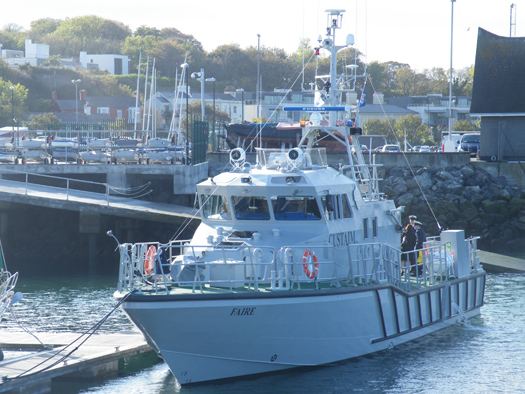
RCC Faire at Howth Harbour on the day of her naming ceremony on 16 October 2009. Photo: Jehan Ashmore / ShipSNAPS
To be broadcast in six-parts, the series will provide unprecedented access into the daily operations of the custom officers.'Customs' examines how the country is dealing with increasing levels of illegally imported materials and substances.
Custom officers found shipments of drugs in the strangest places: a doll's house, picture frames, the bottom of a massive cargo ship. In addition the seizure of contraband cigarettes, vehicles, large
quantities of money and the more bizarre discovery of a Colombian snake.
Joe English Lunch in Howth Yacht Club
Howth Yacht Club is staging a lunch to help Round the World skipper Joe English who has been diagnosed with Alzheimers disease according to a note on the club website.
Coming from a career in sailing that started in 1976 in North Sails' Kinsale loft, Joe is probably best known for his role as Skipper of NCB, the Irish maxi yacht which competed in the 1989 Volvo Ocean Race.
He also took over as Skipper of Toshiba in the 1997 race. More locally, Joe was an innovator in the Cork 1720 project in conjunction with Tony Castro.
In recent years, Joe has been diagnosed with Alzheimer disease at a very young age and recently featured in a Prime Time documentary on RTE on the subject. A charitable trust has been launched to help Joe and his family over the coming years and this year's HYC Christmas lunch is to benefit this worthy cause.
The lunch is on Friday, 10th December
MacSweeney Receives British Honour for Maritime Journalism Work
For the first time an Irish maritime journalist was honoured by the British Maritime Foundation at its annual awards ceremony in London. The Desmond Wettern Award was presented to Afloat's Tom MacSweeney. It is made to the writer, broadcaster, journalist who in the opinion of the Foundation's Awards Committee has made the most constructive contribution to generating awareness of maritime issues.
The Awards Committee said that the significance of issues chosen, work in radio, television and newspapers and magazines, the range and depth of analysis and impact on public awareness of maritime issues were the reasons for the award to be made to a journalist outside of the UK for the first time.
There was a £1,000 award with the trophy which MacSweeney donated at the ceremony back to the Foundation for support to their work, particularly in the area of tall ships opportunities and sea training for young people. The Foundation will be offering places to Irish people and are interested in extending the work of the Foundation to Ireland.
The Award was presented by Countess Mountbatten, President of the Maritime Foundation at a ceremony in the Institute of Directors building in Pall Mall, London.
Tom MacSweeney is a columnist with Afloat, Ireland's national sailing magazine and Special Correspondent with Ireland's national fishing industry newspaper, The Marine Times. He was formerly Marine Correspondent with RTE, Ireland's national radio and television service and is a former winner of Ireland's maritime person of the year award as well as a maritime author.
TV historian Dan Snow won the Donal Gosling Award for his four-part BBC2 series, Empire of the Seas. This is for the best television, film or radio contribution.
Over 200 celebrities, journalists, business figures and senior naval officers attended this year's Maritime Media Awards, held at the Institute of Directors in London Foundation president Countess Mountbatten of Burma presented prizes to winners of the six categories:
• The Desmond Wettern Media Award for the best journalistic contribution – freelance writer and broadcaster Tom MacSweeney for exemplary coverage of maritime matters
• The Donald Gosling Award for best television, film or radio contribution – Dan Snow, Empire of the Seas
• The Desmond Wettern Fleet award for best media contribution from HM Ship, submarine, Royal Navy Air Squadron or Royal Marine unit – HMS Kent
• The Mountbatten Maritime Award for best literary contribution – Richard Guilliatt and Peter Hohnen, The Wolf
• The Maritime Fellowship Award for an outstanding lifetime contribution in a particular maritime field – Undersea explorer David Mearns
• The Society for Nautical Research Anderson Medal for best contribution to maritime history – Nicholas Black, Head of History, Dulwich College for his book, British Naval Staff in the First World War
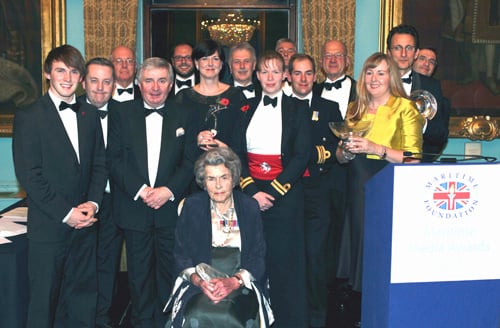 \
\
The awardees in Pall Mall
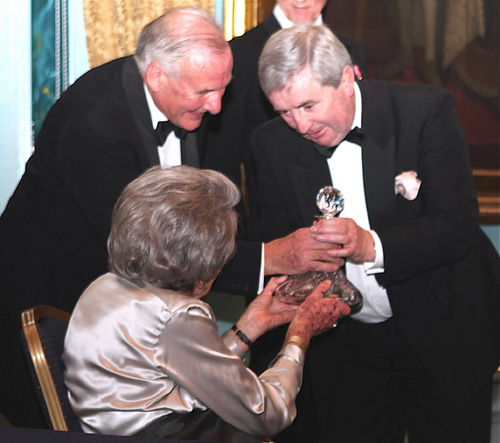
Tom MacSweeney receives the award from Countess Mountbatten
Read Tom MacSweeney's weekly 'Island Nation' blog HERE
New Rescue Series Airs on RTE This September-Promo Vid Here!
Rescue 117 is RTÉ’s new 6 part documentary series capturing rescues as they unfold from the Irish Coast Guard’s helicopter search and rescue base in Waterford, Ireland. The series airs on RTE1 at 8.30pm on 14th September. A promo video is below
New RTE Documentary Series on Irish Fisherman
RTE turns its cameras on Ireland's fishermen in a six-part series starting this Sunday on RTE One. Skippers takes the Irish audience aboard working fishing vessels in the Irish fleet to meet the men who lead these boats; the Skippers.
Crews in pursuit of their lucrative catch, involving long absences from home, 24 hour shifts, huge waves, 80-mile-per-hour gales, and the unpredictability that is the ocean itself are part-and-parcel with this job.
The series was shot by DV Directors who ate, slept, breathed and fished with our Skippers while they were out on the high seas in the world's most dangerous job, creating a sense of immediacy with the audience at home; bringing the action, and turmoil wave by wave, roll by roll. Visually stunning images of the Irish coastline and sea wildlife, along with the roaring ocean will compliment the strong-character presence of our Skippers and their crews, with the illusive lights of home becoming a beacon in the night for the Skippers as they make their way ashore after their gruelling trips.
In the first episode, two former construction workers try to make a go of it at sea, a fisherman's wife tells her story, and a mystery fish causes havoc for a trawler crew and a rookie skipper feels the pressure to make the grade.
THE SKIPPERS
DAVID PRICE:
Howth in North County Dublin is home to the Price fishing family and youngest son David is carrying on the tradition as an energetic skipper on his fathers 60 foot, €2 million trawler "The John B". David is fishing 80 miles off the east coast of Ireland in search of prawns. Times have changed for David as he has to work twice as hard as he did five years ago when he used to sell his prawns for double what he's getting for them today.
David is frustrated with regulations that make little sense. He has to throw away perfectly good fish due to quotas. The pressure of costs versus the price he is receiving for his catch is not adding up and this frustration is sometimes taken out on his crew.
The collapse of the building industry has meant that some Irish are looking at fishing again for work. This trip has brought on board two former construction workers John and Emmet who both want to make a go of it in the fishing business. For John it's a big change from his previous job as a plumber but he's hoping he won't have to be fishing for too long.
This trip will be make or break for the two Irish lads as David has to decide if they are cut out for the hard life at sea.
His training is tough and they won't be getting any special treatment.
ROSS CLASSON:
Portnoo in Donegal is home to 42-year-old skipper Ross Classon. He's been fishing since he was 15. But Ross has no family background in the industry and is the son of a school principal. He went to sea purely because he loved it. This comes with a price to pay as he has less time to spend on shore with his family, when he does come home it is not long before Ross has to leave again.
His wife of 25 years, Anna, remembers the strain of bringing up their sons while Ross was out at sea. Anna has learned to deal with not seeing Ross for weeks at a time, she's learned to cope but she knows other families who haven't found things so easy. Ross's boat is based in Ullapool, Northern Scotland. He has to make the 430 mile journey by road and sea.
MICHAEL MEADE:
60 miles off the south coast of Cork is skipper Michael Meade. He's been fishing for the past 25 years and has owned his trawler the Buddy M for the past 10 years. Along side Michael are four regular crew members including Brendan from Cork and Sergey from Warsaw. Michael has seen the fishing industry slowly being eroded and is not too hopeful for the future. He fishes out from the small port of Cross haven in Cork.
CATHAL O'SULLIVAN
The old fishing village of Castletownbere in Co. Cork is where the ambitious and determined Cathal O'Sullivan is based. Cathal has no background in fishing and originally comes from Kenmare in Kerry. He started fishing at 16 and now at 24 is one of Ireland's youngest skippers in charge of the 40foot trawler the Tea Rose. This €1 million boat is owned by Paddy O'Sullivan who has recently put his faith in Cathal to go it alone.
Cathal leaves behind a young family, his son gets upset each time Cathal leaves , but Cathal's duration at sea is getting longer due to the rising price of fuel and the decrease in the value of his catch. He often will do three fishing trips in a row leaving his family for up to 20 days at a time. With every trip comes the pressure of finding a good catch for the crew in order for himself and his men to earn a decent wage
Welcome to Afloat TV

Since 2003 the team behind Afloat magazine has also been producing high-end, internationally appealing and entertaining factual documentaries on the Irish waterways. The production team are a mix of creative, technical and business people whose expertise guarantees an innovative approach to production and a high-quality finished product. The focus is on marine based programmes which entertain and educate. The work has been broadcast on RTE One and internationally on Sky Channels.
The Bay
Screened on RTE One in 2005.
Take a trip around the one half of Ireland's capital city you probably know the least. A new four-part documentary series, The Bay will be screened over four consecutive Wednesdays in May. Using spectacular aerial and underwater footage, the series features a combination of personality-led interviews and themes to tell the story of Dublin's unique waterway. Dublin Bay stretches over six kilometres, from Howth Head on its northern tip to Dalkey Island in the south. It's a place most Dubliners simply take for granted, and one of the capital's least visited places. But there's more going on out there than you'd imagine. And that's why The Bay was made. The series introduces viewers to the rich diversity of activities and personalities around the bay, while also touching on the serious environmental and political issues facing it. Find out more about the bay here.
The Harbour
Screened on RTE One in 2007.
It’s one of the largest natural harbours in the world – and those living near Cork Harbour insist that it’s also one of the most interesting. This was the last port of call for the most famous liner in history, the Titanic, but it has been transformed into a centre for chemical and pharmaceutical industry. Giraffe wander along its shores, from which tens of thousands of men and women left Ireland, most of them never to return. The harbour is home to the oldest yacht club in the world, and to the Irish Navy. This deep waterway has also become a vital cog in the Irish economy. ‘The Harbour’ is not a history programme, nor is it a news focus. It’s simply an exploration of this famous waterway, its colour and its characters. Find out more about the harbour here.
The Estuary
Screened on RTE One in 2007.
The story of the Shannon estuary might well be one of neglect, except that against the odds this waterway has become one of Ireland's greatest natural resources. Windswept, sitting on the edge of the Atlantic, often ignored by the nation. The story of the Shannon estuary might well be one of neglect, except that against the odds this waterway has become one of Ireland's greatest natural resources. A new four-part documentary series, from the makers of RTÉ's The Bay and The Harbour series, uncovers the secrets of the Shannon Estuary. From flying boats to film-making, wildlife to wind-farms, the series reveals how a 100km-stretch of the Shannon waterway has become a hotbed for innovation in Ireland. Up to 40% of Irish energy needs are met here, on the shores of a waterway that is also home to Ireland's second largest airport, a 10,000 student university and a massive cargo port. Ireland - and the world - has learned from the estuary. The first duty free shop was opened here, along with the first industrial free zone. Over the years, thousands of business and political leaders from across the globe have come to Shannon to discover its secret - in the hope that they might copy it. Long before Ireland heard of green energy, this place was producing it. Listen in to dolphin conversations beneath the Shannon's waterline. Uncover the mystery of the Ark, the church on wheels built by a priest who prayed when the tide went out. Narrated by Brenda Fricker, the series aired on Friday nights at 7.30pm on RTÉ One from May 4th 2007. Find out more about the estuary here.
The Navy
Screened on RTE One in 2007.
60 years of the Irish Naval Service. Celebrating the 60th anniversary of the Irish Naval Service, this 3 x half-long feature documentary shows how the Service has evolved into a multi-tasking, multi-disciplinary force. Most Irish people rarely come into contact with the Naval Service, and so are unaware of the range of activities it undertakes. This documentary provides an ideal opportunity to reveal the full extent of the Service’s duties – and the commitment of those who serve on Ireland’s fleet.
The Regattas
Screened on RTE One, 2007 and Sky Sports in 2009.
Sailing featured in RTE’s Christmas schedules this year, with the broadcast of a half-hour documentary feature on the Volvo Dun Laoghaire Regatta 2007. The production, entitled ‘The Regatta’, was shot over four days in Dublin Bay during this year’s regatta. Made by Baily Films, the company behind earlier critically-acclaimed water-based documentaries The Bay, The Harbour, The Estuary and The Navy, it features spectacular on-board footage from a range of craft competing in the event. The Regatta takes viewers both on board the competing craft, and behind the scenes, to examine the challenges thrown up by organising such a large-scale event on the bay. The Regatta was broadcast on RTE 1 on Saturday, December 22, at 4.20pm.
IN DEVELOPMENT
Afloat TV projects at an advanced stage of development include:
The Edge of Ireland
Ireland’s attitude to the seas that surround her is one of the most curious in the world. An island nation, with more coastline than most other European nations, most of her citizens look inland.
Yet no-one in Ireland lives further than 100 kilometres from the sea, and the majority of the population are housed within 10 kilometres of the coast.
More than any other European nation, our history is written on our shores. The very first settlers clung to it, fearing to explore inland. The shores fed and sustained them, and continued to sustain communities from Malin Head to Mizen Head for the next 9,000 years.
From the fort of Dun Aengus to the fields at Carnsore Point, from Inishvickillane to Bull Island, the coastline holds a key to our understanding of Ireland and ourselves.
The Edge of Ireland will uncover that hidden history of Ireland, and explore what the future holds for our coastline. Travelling around the coast, it will use local and national experts to relate individual accounts of how the sea has connected with the land to shape a local community or the nation at large.
The six half-hour series will be presented thematically, rather than using a linear journey up and down the coastline.
CONTACT
If you're keen on promoting Ireland's waterways and would like to get involved with Afloat TV please email us here.


























